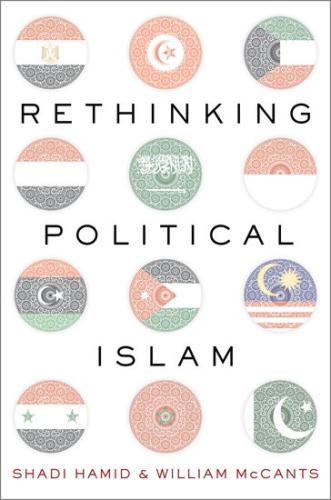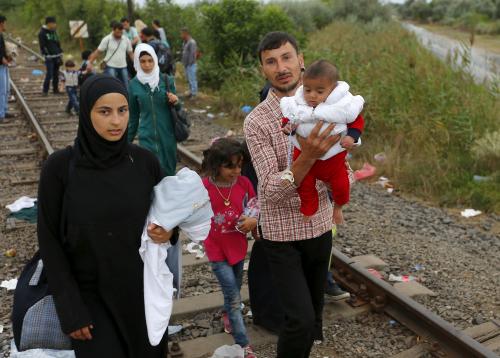This reaction essay is part of the Brookings project — “The One Percent Problem: Muslims in the West and the Rise of the New Populists.” We asked each author to reflect on how reading the other working papers helped them think differently about their own country of focus.
Across Western democracies, populists have crafted stories of a political establishment serving demands of “outsiders” instead of the interests of “the people.” In 2016’s “populist moment” that rode on the back of 2015’s European migrant crisis, Muslims often became the “outsider” scapegoat of choice. Yet the actual presence of Muslims in each country ran the gamut. In Poland and Hungary, right-wing populists entrenched their power, respectively, in part by instrumentalizing the threat Muslims could pose. In Italy and Sweden, huge surges of Muslim migrants tested the capacity of the political establishment, helping populists gain considerable traction.
Yet, in light of the COVID-19 pandemic, governments — populist or not — will be tested by a new type of crisis. As such, the staying power of populist parties that have rhetorically focused on the threat of migrant Muslims will also be tested. It appears that the future success of these parties may depend on their ability to diversify their narratives and effectively pivot their messaging to maintain relevance.
Populists who utilize a variety of narrative “tools” are likely to prove more durable than parties which consistently center the threat of Muslims and migration as their only differentiating message. Populist parties that put forward a more comprehensive nationalist narrative (limiting the power of supranational bodies like the EU, religious traditionalism, curbing general immigration, and scapegoating a more “diverse” range of cultural “others”) are in a better position to pivot when new circumstances arise. For instance, Hungarian Prime Minister Viktor Orbán and his party gained majority power before the migrant crisis with a variety of scapegoats, such as the Roma, political elites, and the European Union. Elevating the potential threat of Muslim migrants was a more recent phenomenon. His breed of nationalism gives him a more varied set of narrative tools that justify affording him more power by focusing on any and all “foreign” threats to the nation, be they biological, supranational, or cultural.
Similarly, Poland’s Law and Justice rose to power on messages of nationalism, Euroscepticism, and Christian preservation. The 2015 migrant crisis gave the party an opportunity to ignite fear of potential Muslim migration and an EU that might force refugee relocation to Poland; that crisis helped lift them to an outright majority in the Polish parliament — a first for any party in Poland since the end of Communism. In the United States, Trump’s conveniently vague call to “Make America Great Again” also utilizes a variety of nationalist tropes and threats to the nation. Islam is not always public enemy number one — arguably the media itself and its “negative” coverage are Trump’s preferred scapegoats. Such parties and leaders with diversified and flexible narrative assets tend to be more resilient in the face of new crises.
Populist parties that focus primarily on Muslims or Muslim migration without addressing other issues such as healthcare or economic issues are less “narratively” resilient.
Populist parties that focus primarily on Muslims or Muslim migration without addressing other issues such as healthcare or economic issues are less “narratively” resilient and may become less relevant as public attention shifts to different challenges. On one extreme, the Netherlands’ Party for Freedom (PVV) is defined by an extreme fixation with Islam. This inhibits their political flexibility to ever really gain significant power. In Austria and Denmark, populists lost their competitive edge when mainstream parties absorbed the radical right’s positions on Muslim migration.
The long-term efficacy of focusing on scapegoating Muslims and Muslim migrants could also be dependent on their demographic presence. One must ask how much a populist party is simply inflating a media crisis du jour – such as the migrant crisis of 2015 — versus addressing a variety of real, lived challenges of people who think the establishment forgot them. In countries like Germany or Sweden, where unusually large numbers of refugees entered the country, recently arrived Muslim migrants may have a more persistent and noticeable presence that poses ongoing challenges to economic and cultural integration.
Prior to the pandemic, the Sweden Democrats found a powerful narrative in harping on the failure of political elites to handle the large migrant influx as well as perceived failures in improving healthcare and eldercare. Standing apart from most of its neighbors, the Swedish government has taken an unorthodox approach to the coronavirus by not mandating quarantine, which, at the time of writing, has resulted in the highest per capita death rate of the Nordic countries — though this may change as countries continue opening up. If the establishment response meets growing public disapproval, it could leave an opening for opportunistic populists. If the public generally views the government response as effective, it could lead to increased trust, stunting populist momentum in the process. The jury of Swedish public opinion is still out: some YouGov polls show split trust in public health authorities while the center-left Aftonbladet newspaper poll shows 70 percent support.
During the first wave of the coronavirus, governing parties in Europe– populist or not–mostly gained in the polls, with opposition parties in decline – the so-called “rally ‘round the flag” effect, pandemic edition. This was most markedly the case in Germany, where support for Angela Merkel’s Christian Democratic Union shot up, cutting into that of insurgent parties. Sweden also reflects this trend. When my paper — “The Rise of Sweden Democrats: Islam, Populism and the End of Swedish Exceptionalism” — was published in March 2020, the Sweden Democrats and Social Democrats were tied in opinion polls. By the end of April, however, the Social Democrats found their way to the top again by 8 percentage points. Unless there is a way to sow popular opposition to the government’s response to a virus that potentially threatens the life of every citizen (compared to migration), trying something “new” politically could be too disruptive and too risky in an already dangerous time.
So far, the Sweden Democrats have not gone on any significant public offensive, as the government’s response is not based solely on political decisions; Sweden’s constitution has ministerial rule, or the separation of political appointees from autonomous administrative agencies like the Public Health Agency. The non-political administrative establishment is more consistently respected and supported than any one political party and the distinction between them is widely understood by citizens. Despite global trends of dissatisfaction with experts, blaming the pandemic crisis on “the establishment” in the Swedish case is more complicated than blaming a political party deciding to accept migrants en masse. That said, in response to the pandemic, Sweden Democrats leader Jimmie Åkesson has called for more testing, the regionalization of property tax to support more rural and economically struggling areas, and a massive stimulus package of 10-20 percent of GDP. Of course, it is always easy to suggest moonshots as a minority party. But what of their core issue: Muslim migration?
Depending on how the public perceives the government’s response in the long term, the Sweden Democrats’ core narrative, that Muslim migration contributes to the decline in healthcare and eldercare quality, could be deployed in a number of directions. This includes blaming death or infection rates on the cultural practices of Muslim migrants or pointing to other government failures in healthcare provision. Already, there are inklings that the Sweden Democrats might be connecting the dots of Muslim immigrants, the high rates of infection in eldercare homes, and Sweden’s high death rates. A recent Guardian piece notes that the former chief epidemiologist Johan Giesecke linked the failure to protect the elderly with the lack of understanding of virus precautions in the largely immigrant eldercare workforce – a trope that has been picked up by the Sweden Democrats and spread online.
The country’s alternative media ecosystem — which fueled the Sweden Democrats’ rise with its stories of Muslim immigrant crime — has seen its narratives spread internationally, such as through Youtuber Tim Pool and Breitbart. Right-wing populists around the world share rhetorical styles, media tactics, and narratives, offering an alternative to the “mainstream” or “elite.” Going forward, will populists be as powerful globally if they do not have a common enemy in Muslims? Will they be able to articulate a collective nationalist-populist narrative with new enemies — and, if so, who would those enemies be? One thing is for certain: the panic surrounding the global pandemic has fueled an ongoing “infodemic” — an epidemic of online misinformation and conflicting narratives, which could continue to undermine any shared sense of scientific fact and social cohesion long after COVID-19 subsides.
The Brookings Institution is committed to quality, independence, and impact.
We are supported by a diverse array of funders. In line with our values and policies, each Brookings publication represents the sole views of its author(s).







Commentary
What makes populists more (or less) resilient over time
June 16, 2020